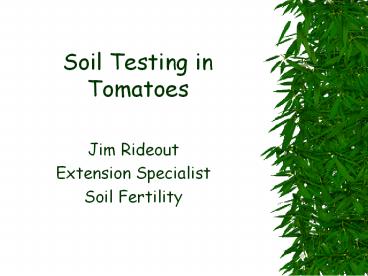Soil Testing in Tomatoes - PowerPoint PPT Presentation
Title:
Soil Testing in Tomatoes
Description:
Soil Testing in Tomatoes Jim Rideout Extension Specialist Soil Fertility The Main Idea Other Reasons Routine monitoring can spot nutrient problems before they become ... – PowerPoint PPT presentation
Number of Views:189
Avg rating:3.0/5.0
Title: Soil Testing in Tomatoes
1
Soil Testing in Tomatoes
- Jim Rideout
- Extension Specialist
- Soil Fertility
2
The Main Idea
Maintain growth while applying only those
nutrients which can not be supplied by the soil
in adequate amounts
3
Other Reasons
- Routine monitoring can spot nutrient problems
before they become nutrient deficiencies - Mountain soils are extremely variable
- Fertility can be considered part of a good IPM
program
4
How Tomatoes Differ from Agronomic Crops
- May have drip fertigation
- Must manage calcium
- Need to consider source of nutrients
- Earliness and quality are important
- High value per acre
5
Soil Analysis Basics
6
NCDACS Agronomic Division
- Soil
- Plant tissue
- Irrigation water
- Nutrient solutions
- Nematode assay
7
What Does Soil Analysis Measure ?
- The extractable nutrient concentration in a soil
sample - Does not measure the total nutrient concentration
- Estimates the ability of the soil to supply
nutrients to a crop - Optimized for annual row crops
8
Recommendation Philosophies
- Crop Response
- Nutrient Replacement (maintenance)
- Nutrient Buildup
- Cation Balancing
- NC Recommendations
- Crop response some maintenance
9
Soil Sampling Methods
10
Importance of Collecting a Representative Soil
Sample
- One acre of soil, 6 deep, weighs about 2,000,000
pounds - Weight of soil in box about 1 pound
- Weight of sample analyzed is about 2.5 g (1/10)
of an ounce
11
Selecting Areas for Routine Sampling
- Areas should be less than 5 acres
- Similar soil type and crop history
- Similar fertilization history
- Keep blocks same year to year
12
Soil Sample Handling
- Mix cores well in clean plastic bucket
- Fill box to line
- Do not oven-dry sample
- Send sample in for analysis as soon as possible
13
Stick With Your Lab
- Different reporting units
- Different soil extracting solutions
- Different yield assumptions
- Different recommendation philosophies
14
NCDA Sample Volume
- 252,025 soil analyses last year
- Turnaround time varies by month
- 7 to 10 days in summer
- February 2004
- 5 to 6 weeks
15
(No Transcript)
16
New codes
Will reduce lime recommendation to account for
un-reacted lime
17
Interpretation of Results
18
Now What Do I Do?
19
Crop Information
20
Basic Soil Information
21
Soil pH and Lime
22
Lime Recommendations
- Actual pH
- Acidity (buffer pH)
- Target pH (6.5 for tomato)
- Residual credit for applied lime
- CANNOT make an accurate lime recommendation based
on pH alone
23
Nitrogen
Based on crop code, not on test results
24
NCDA Index System
- Unique to North Carolina
- Converts nutrients to common units for
interpretation - Used for P, K, Mn, Zn, Cu, S
- Similar to index used for tissue
25
Soil Interpretation Indices
26
Phosphorus and Potassium
27
Calcium and Magnesium
- Expressed as percent of CEC
- May determine the type of lime needed
- Need to consider CEC for gypsum applications
28
Calcium and Magnesium
29
Micronutrients and Sulfur
30
Salinity Information
31
Additional Information
32
(No Transcript)
33
Fruit Calcium
34
Causes of Low Fruit Calcium
- Low soil calcium
- Low soil pH
- Nutrient imbalances
- Excessively wet or dry soil
- Large fruit
- Variety differences
35
Cation Balance and Fruit Calcium
- Must balance calcium, potassium and magnesium in
the soil - Excessive potassium fertilization can reduce
fruit calcium content - Excessive magnesium fertilization from dolomitic
lime can reduce fruit calcium content
36
----------
----------
K K
Ca
K K
K K
Ca
Ca
Mg
K K
Ca
Mg
H H
Ca
37
Questions?































